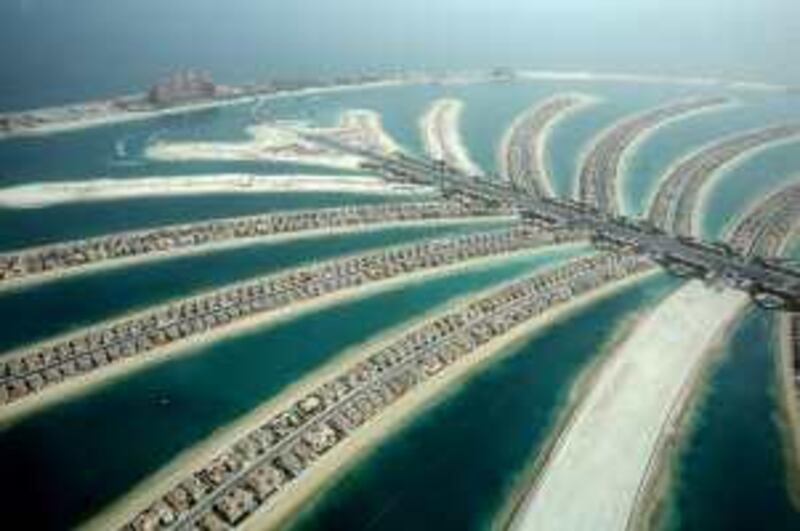DUBAI // UN scientists say that although the waters off Dubai's coast will never again be what they once were, the Palm Jumeirah offshore structure is creating a new complex marine ecosystem despite years of disruptive construction work. The United Nations University's International Network on Water, Environment and Health, commissioned by the Palm developer Nakheel, compiled a report on the effects of the project.
They concluded that marine life is slowly returning to the coastline. "They are developing into very interesting rocky reefs," said the chief scientist behind the research, Dr Peter Sale, a marine ecologist. Dr Sale is the assistant director of the United Nations University network, which has worked with Nakheel since early 2007. The goal of the collaboration is for the scientists to pursue a long-term environmental monitoring programme and a sustainable management plan for the waters surrounding Nakheel's man-made islands.
Nakheel's decision to build a series of structures along Dubai's coastline has drawn criticism from conservationists opposed to the environmental cost of the projects, such as large-scale destruction of coral reefs and changes in water flows. The Palm Jebel Ali, for example, is being built in a formerly protected area, the Jebel Ali Marine Sanctuary. The area was given legal protection in 1998 on the grounds that it housed one of the Gulf's richest marine ecosystems, with 34 coral species and 77 species of reef fish. To mitigate the damage it has caused, Nakheel financed a scheme under which the Emirates Marine Environment Group, an NGO, transplanted corals elsewhere.
Despite initial positive results, the long-term benefits are still unknown. Yesterday, the UN scientists acknowledged that the ecosystem that existed off Dubai's coast has been lost forever. "There are certainly going to be differences," said Dr Ken Drouillard, associate professor at the Great Lakes Institute for Environmental Research and Biological Sciences at the University of Windsor, Canada, who participated in the study.
"Much more complex habitat characteristics were present in the past." Dr Sale said about 100 species of fish and 20 coral species have been recorded in the areas around the outward side of the breakwaters of the Palm Jumeirah. "In 20 years' time you will have a more interesting marine environment than you had before," he said. "There will be many conservationists who will disagree with me." But as population growth intensifies the pressure to build, conservationists will have to let go of "the idea that the world is going to be one big protected area that we do not disturb".
"You will have to get rid of the people," he said of the alternative. The United Nations University study has important political implications for the future of artificial marine structures. If it is proven that productive communities can thrive around such structures, opposition to such projects in other emirates and countries will be weakened. It is precisely because of these far-reaching implications that a UAE-based marine scientist has called for caution.
"This is not a straightforward issue," said the researcher and policymaker, who spoke on the condition of anonymity because he works for a government department. "Breakwaters will increase the possibility of erosion and bring sediment," he said. Sediment will impede the growth of corals. "There are two schools of thought on artificial structures. Some scientists think fish come to that area not because the number of fish has increased but because other habitats have been destroyed."
A marine scientist who is familiar with the area and also spoke on the condition of anonymity said that while some species would fare better, others would be jeopardised. "What about other species such as green turtles that are dying?" he said. Pollution, development and climate change are threatening the future of many ocean ecosystems. Stemming Decline of the Coastal Ocean, which Dr Sale compiled, says that by 2050, 91 per cent of the world's coastlines will have been affected by development, much of it poorly planned.
"Shorelines are hardened, channels and harbours are dredged, spoil is dumped, and submerged and emergent land is moved. Patterns of water flow are modified, and pathways used by organisms in their movements from nursery to adult habitats and spawning sites may also be modified or blocked," the report says. Businesses and governments can sometimes form "powerful allies in favour of coastal development even when it is environmentally and socially unsustainable".
Dr Sale said that while it is legitimate for the report to be critical "because there have been lots of bad practices in many places", the projects Nakheel have built and are building "are not impossible to manage sustainably". Dr Drouillard said some of the challenges to the project stem from the lagoon's environment, with reduced wave action that which can promote algal blooms. The scientists have also identified sites where organic carbon is prone to depositing, causing a lack of oxygen in the water and resulting in fish kills.
Other pressures will appear as more and more people populate the islands. Preventing these problems from occurring will require "proactive monitoring" and a sustainable management plan, Dr Drouillard said. vtodorova@thenational.ae






